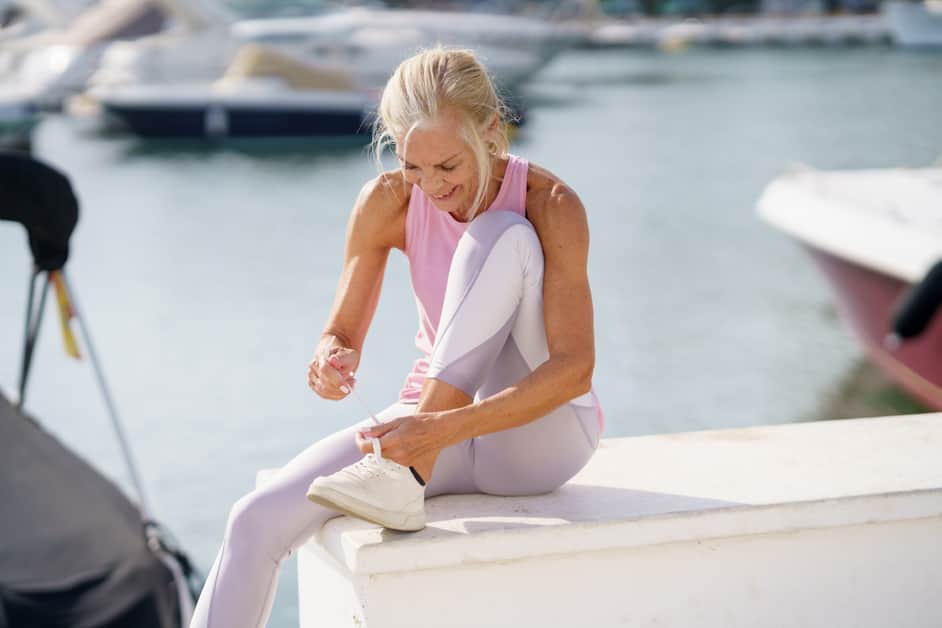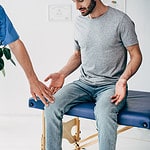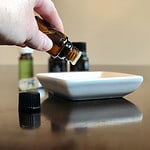Introduction
When searching for a knee pain relief solution, insoles make a great choice. With various sizes, shapes, and materials available, you’re sure to find the right one. Insoles provide support and cushioning for your feet, thus reducing knee strain. This can provide relief from mild to moderate knee pains, and help prevent more serious issues.
To select the best insole, start by understanding your individual needs. Consider what activity causes you pain, so you can make an informed decision. Depending on the activity, certain materials will provide more comfort and protection. Additionally, illnesses and chronic conditions should be taken into account. Select an insole that fits properly in your shoes, without bulging or being too tight.
To help choose the perfect shoe insole, here is a guide to five common materials used for orthotic insoles. Their benefits related to knee pain relief and potential drawbacks are also included:
- EVA foam
- Gel
- Cork
- Leather
- Rubber
Causes of Knee Pain
Knee pain can have many reasons. The main one is due to aging, which causes more wear and tear. Other causes are injuries, repeating the same movements, diseases or not having the knee joint in the proper alignment.
If you have knee pain now and then or all the time, knowing the reason for it can help you find relief.
Osteoarthritis
Osteoarthritis (OA) is the most common form of knee arthritis. It occurs when cushioning cartilage and other soft tissues are weakened. Symptoms of OA in the knee include pain, swelling, stiffness and instability. It can also affect other parts of the lower body, like the hips, feet and ankles.
Shoe insoles may help people with OA. They provide cushioning and shock absorption to reduce stress on the joint. Plus, they can be customized to fit a person’s unique body shape. This helps keep the joints in their best alignment, which helps prevent pain.
Knee braces can also help those with OA. They support weakened muscles and tendons and keep bones aligned. This stops further damage to cartilage and reduces pain due to movement. For severe cases, orthopedic surgery might be needed if other treatments don’t work. The aim is to reduce pain and improve knee joint function.
Injury
Knee injuries are common and can cause pain, swelling and stiffness. It is the most injured joint in the body and can happen from falls or twisting when doing sports, jumping or running. Symptoms vary, but can include swelling, extreme pain when walking or moving the joint, popping or cracking noises, and difficulty straightening the leg.
Acute traumatic injuries should have prompt medical attention. Examples of injuries include: ligament sprains or tears (torn ACL, torn MCL), meniscus tears (cartilage tear), dislocated kneecap, fractures (broken bones), and tendinopathies (tendonitis).
RICE remedy (Rest, Ice, Compression, Elevation) is used to reduce inflammation and pain and to promote healing. In some cases, orthotics/orthopedic shoe inserts can cushion the knees where pressure or strain is high due to irregularities in walking patterns or gait.
Overuse
Knee pain may be caused by overuse. This includes running, jumping, soccer, basketball, rugby, weightlifting, aerobics and dancing. Wearing the wrong shoes or poor posture when sitting or standing can also be culprits.
If the cause is overuse, one may notice a dull ache in their kneecap when they move it. Arthritis or cartilage tears can make the pain more intense. For these cases, treatment usually involves medication and rest instead of shoe insoles.
If your pain is due to overuse and not medical conditions, insoles for your shoes may be helpful. There are insoles for walking, running, sports and daily life. They support the feet and cushion the knees, reducing the impact on them which, over time, can become more serious.
Benefits of Shoe Insoles
Shoe insoles are a great way to soothe knee pain! They are made to add extra cushioning and support. This helps reduce stress on the lower limbs and knee joints. Moreover, shoe insoles reduce friction. Resulting in more comfortable and secure footing.
Let’s look at the other advantages of shoe insoles for knee pain relief:
Improved Comfort
Wear insoles in your shoes. They cushion and support your feet. This comfort lessens the weight of your body, helping to decrease knee pain. Plus, good insoles can absorb shock when you move. They offer extra support at key points in your foot, which reduces tension in the feet, ankles and knees. This lowers pressure when walking/running, enabling those with knee pain to keep going with less trouble.
Reduced Pain
Shoe insoles can help ease pain caused by knee degeneration or arthritis. They reduce pain in the joint and increase stability. Insoles also redistribute pressure in the foot, so hot spots that arise from ill-fitted shoes can be relieved.
The insoles provide support for the arch and heel, to counterbalance any uneven weight bearing. They evenly spread body weight across both feet, giving uniform support. There’s also the added bonus of shock absorption when running or walking, plus they can lessen pain when controlling movement.
These insoles are crafted from flexible materials that fit the contours of the foot, providing comfort and lessening strain on painful joints. Plus, they are made with medical-grade materials, so they can treat various conditions, such as plantar fasciitis or tendonitis of the ankle. Also, they help with shin splints and even arthritis of the knee joint.
Shoe insoles are great for helping people manage chronic joint pain, so they can live life to the fullest!
Increased Stability
Shoe insoles offer more stability to the feet and ankles. This can prevent strain while walking or running. It also helps reduce stress on different body parts – including the knees – lessening the chance of getting hurt.
Arch support insoles can spread body weight across both feet and give cushioning for bumpy surfaces, which relieves pressure on knees and ankles.
When getting an insole, pick one that fits your foot shape and provides arch support. It could be beneficial to get an insert for motion control and pronation control. This is especially important for people with weak ankles or knee pain. In this way, shoe insoles can correct any unnatural pronation patterns or bad posture that may lead to knee pain. Plus, they offer extra protection from past injuries.
Types of Insoles
Knee pain relief? Shoes insoles are a great option. What kind to use? Depends on your needs. Here’s the lowdown:
- Different types of insoles.
- Different levels of support.
- We’ll tell you all about ’em.
Heel Cups
Heel cups are a popular type of insole. They provide cushioning and shock absorption in the heel, lessening fatigue and pain. An injected rubber or plastic piece is contoured to fit into the heel, creating a cup-shape when inserted. This shape gives arch contact and stability, plus reduces pressure on feet and ankles – great for knee pain!
These insoles are durable and keep their shape, so they stay strong in the shoe. They are often used for those with moderate knee pain, needing extra support throughout the day. They are also helpful for high arches and pronated feet. Heel cups give extra comfort, posture and stability in dress shoes.
Gel Insoles
Gel insoles are molded to fit your feet snugly. Memory foam core offers unbeatable comfort and shock absorption. Plus, the cushioning distributes pressure along the foot for extra support. The gel absorbs moisture away from your skin, preventing sore feet. These insoles are long-lasting, durable and easily movable between shoes. Maximum convenience and cost savings!
Custom Insoles
Custom insoles are pricey, but very effective. They are molded to your foot and crafted with your needs in mind. They fit perfectly in your shoes and give you stability by distributing weight. They help reduce fatigue due to misalignment. They also cushion your heel, provide arch support and superior shock absorption compared to other insoles.
To get custom orthotics, a prescription from a doctor or certified professional is needed. You may need extra fittings or visits to adjust for comfort or fit.
How to Choose the Right Insoles
Shoe insoles are not the same. To choose the best ones for knee pain, features and materials should be thought about. Researching can help you make a good choice. Let’s look at what needs to be taken into account when picking insoles:
- Features
- Materials
- Research
Consider Your Level of Activity
When shopping for insoles, your lifestyle and activity level matter. If you’re an athlete, you’ll need different insoles than someone who is sedentary. Look for fully cushioned insoles to absorb shock and provide arch support. They should be contoured to fit your foot and flexible.
Insoles made for athletic shoes can give traction and insulation. For those not doing much physical activity, cushioning without sacrificing arch support is key. An extra deep heel cup gives stability and flexibility. Flat feet should look for insoles with an orthopedic shape made of latex foam or gel for comfortable movement.
Pay attention to the size label on the soles for the right cushioning and support. Thickness and shoe size are important.
Consider Your Foot Type
When choosing shoe insoles to help with knee pain, it’s important to think about your foot type and pronation. Pronation is when your feet and ankles roll inward while walking or running.
Generally, if the foot type is neutral, pronation is not a concern. But, if you have high arches or flat feet, the feet may over-pronate or under-pronate. Over-pronation means the arch turns in too far during a stride; under-pronation means it doesn’t turn in enough.
It’s wise to ask a professional podiatrist or physical therapist to assess your feet for any problems. This will ensure the insoles fit correctly and provide comfort and support, reducing knee pain.
When choosing insoles for knee pain relief, look for insoles with cushioning zones beneath the heel, ball of the foot, and arch area of the forefoot. These zones reduce stress on feet, providing extra support and shock absorption while remaining flexible. Insoles made with memory foam are great for cushioning, and cork adds stability to ease knee strain.
Consider Your Level of Comfort
Choose an insole that is comfy. It should provide support and cushioning. The softer the material, the better it will be at absorbing shock. Check the arch support and if it fits your foot size. Ensure a snug fit around the toes and heels. Go for breathable materials to avoid sweat and irritation.
Conclusion
Choosing the right shoe insoles can really help with knee pain and improve mobility. When buying insoles, consider these tips:
- Choose the correct type, size, cushioning
- Ask your doctor
- Replace when needed
- Use orthotic devices if needed
Taking the time to find the right ones will help you get back to enjoying comfortable movement.
Frequently Asked Questions
Q1: What are insoles for knee pain relief?
A1: Insoles for knee pain relief are orthotic devices designed to improve the biomechanics of the knee joint, helping to reduce pain and improve overall knee health. They are especially beneficial for people suffering from chronic knee pain or those who have recently experienced an injury or surgery.
Q2: How do shoe insoles for knee pain relief work?
A2: Shoe insoles for knee pain relief work by providing additional cushioning and support to the foot and ankle, which helps to reduce pressure on the knee joint. This in turn helps to reduce pain, improve joint stability, and reduce the risk of future injury.
Q3: Are there any risks associated with using shoe insoles for knee pain relief?
A3: As with any medical device, potential risks should be discussed with your healthcare provider prior to use. Generally, however, shoe insoles for knee pain relief are considered to be safe and are unlikely to cause any serious side effects.





